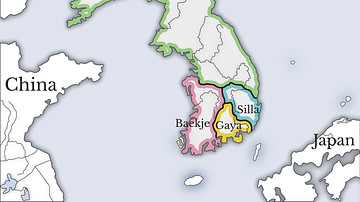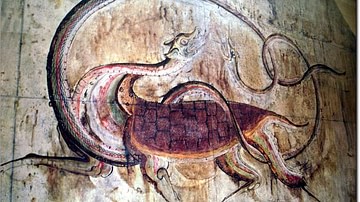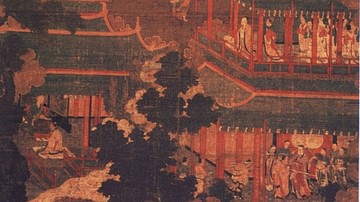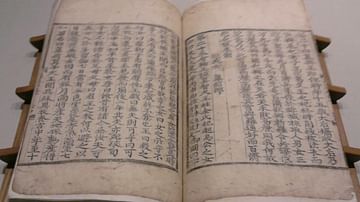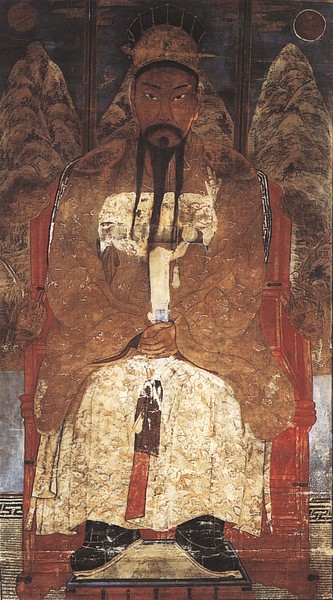
Dangun Wanggeom (or Tangun) was the legendary founder of Gojoseon (Gochoson or Old Choson), the first Korean state which ruled northern Korea in the second half of the first millennium BCE. Gojoseon possessed the most advanced culture in the Korean peninsula at that time and was an important marker in the progression towards the more centralised states of later periods. According to mythology, Dangun was born on the third day of the tenth month and so the 3rd of October is celebrated as National Foundation Day in modern South Korea.
Hwanung & Ungnyo
According to Korean mythology, as recounted in the 13th-century CE Samguk yusa ('Memorabilia of the Three Kingdoms'), Hwanung, the son of Hwanin, the supreme deity, asked his father if he might be allowed to descend to earth and live there instead of heaven. Hwanin consented and, giving Hwanung three seals of authority, selected Mt. Taebecksan (near Pyongyang) as the best place for his son to arrive and settle. With the god came 3,000 followers, including the Earl of Wind (pungbaek), Master of Rain (ubaek), and Master of Clouds (unsa). Hwanung built a town called Asadal on the slopes beneath a sandalwood tree, hence his other name of 'Lord of the Pakdal tree' or Sandalwood Prince. From the mountain, the god dispensed to his followers such quintessential elements of life as culture, agriculture, good and evil, punishments, illness, and lifespans.
One day both a bear and a tiger came to Hwanung's residence in prayer and asked to be transformed into humans. The god agreed to this gift but on the condition that they remain out of the sun for 100 days and eat only a sacred bunch of mugworts and 20 garlic cloves. To this the animals agreed and followed his advice. The tiger was unable to keep up with the conditions, but the bear – a female called Ungnyo – after only 21 days was transformed into a woman. She longed for a child and so, shortly after the god married her, Dangun was born.
The myth of Dangun's birth may symbolise the arrival of Bronze Age culture in Korea when the metal was brought from Manchuria during the second millennium BCE. The inclusion of a bear in the myth may reference the shamanistic beliefs and animal totems of the nomadic tribes who migrated from the Asian interior in this period and settled in the Korean peninsula. The tiger, on the other hand, was often a subject of Korean folk art and so, perhaps, represents the Korean people. Indeed, in this sense, Dangun may be considered the first Great Shaman who provided a link between the spirit and animal world with humanity. The ruler's divinity was also, no doubt, a useful political tool for later kings to claim, via their direct descent, a divine right of rule.
Dangun & Kija
Dangun is traditionally credited with then creating the entire Korean race and ruling over the kingdom of Gojoseon, ancient Korea's first proper state, which was founded in 2333 BCE. Indeed, Dangun's name means 'mountain-birch ruler' or 'altar ruler' and Choson is sometimes referred to as Dangun Gojoseon/Tangun Choson. Needless to say, there is no archaeological evidence for a unified state at this time and historians agree that the historical Gojoseon only existed from the 7th century BCE at the earliest and may never have achieved a fully centralised control of the region.
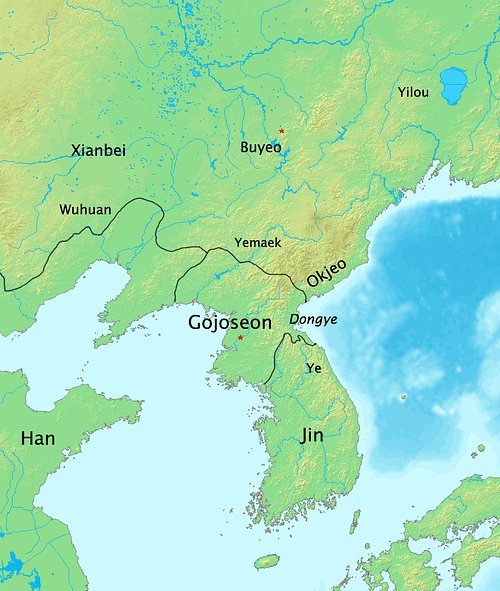
Returning to our myth, after Dangun had ruled for over 1,000 years he decided to become a spirit and live in contemplation at the Heavenly Lake on Mt. Paektu. Dangun's role as king of Gojoseon was taken over by the sage Gija (Jizi in Chinese), who had left the Chou dynasty of China with 5,000 followers and settled in Dangun's kingdom. This happened in 1122 BCE, and the legend may represent the arrival of Iron Age culture to Korea and symbolise early relations between China and Korea, especially the passing on of Chinese methods of administration and government which Dangun is credited with introducing in Gojoseon. It is, perhaps, significant that the myth of Dangun's birth takes place during the reign of the (also mythical) Chinese emperor Yao.
Later Legacy
The Dangun legend has cropped up several times over the centuries and continues to be a powerful myth even today. During the Goryeo dynasty (or Koryo dynasty, 918-1392 CE) Pyongyang was selected as the capital with one of the reasons being that it was the traditional first capital of Dangun and the Korean people. In the art of the Joseon Dynasty (1392-1910 CE) the Shaman Mountain god Sanshin (and later Buddhist bodhisattva) is frequently portrayed in the guise of Dangun wearing a crown. During the Japanese occupation of Korea Dangun was worshipped as a potential returning saviour of the nation by the Taejong-gyo sect. During the Empire period (1895-1910 CE) and again in the Republic of Korea from 1948 to 1961 CE the calendar counted from the Dangun founding date of 2333 BCE. In modern South Korea the 3rd of October, Dangun's birthday, is celebrated as National Foundation Day (Kaechonjol). Finally, evidence that the myth still carries a political resonance is seen in North Korea's claim (unsupported by scholars worldwide) to have actually discovered the tomb of this legendary figure near Pyongyang in 1993 CE and thus considers itself the true home and inheritor of Korea's first cultural hero.
This content was made possible with generous support from the British Korean Society.

